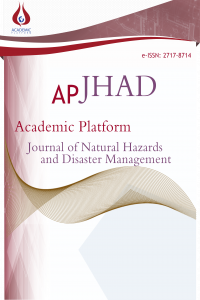Determination of Shear Strength Parameters by Multistage Triaxial Tests in the Long-Term Analysis of Slopes
Determination of Shear Strength Parameters by Multistage Triaxial Tests in the Long-Term Analysis of Slopes
Landslides, multistage triaxial test, Long-term analysis,
___
- [1] Kondner R.L., Hyperbolic stress-strain response: cohesive soils: Journal of Soil Mechanics and Foundations Division Vol. 89 (1963), p. 115-143.
- [2] Sridharan, A. M., and S. N. Rao. 1972. New approach to multistage triaxial test. Journal of Soil Mechanics and Foundations Division 98: 1279-1286.
- [3] Nambiar M.R., G.V. Rao and S.K. Gulhati, Multistage triaxial testing: A rational procedure: Strength Testing of Marine Sediments: Laboratory and In-Situ Measurements Vol. 883 (1985), p. 274-293.
- [4] TS 1500, İnşaat Mühendisliğinde Zeminlerin Sınıflandırılması, Türk Standartları Enstitüsü, Ankara, 2000.
- [5] ASTM. 2015. Annual Book of ASTM Standards. Vol. 04.08 & 04.09. West Conshohocken, PA: American Society for Testing and Materials.
- [6] Ho, D. Y. F., and D. G. Fredlund. 1982. A Multistage Triaxial Test for Unsaturated Soils. Geotechnical Testing Journal (Americal Society for Testing and Materials) 5 (1/2): 18-25.
- [7] Banerjee, A., Puppala, A. J., & Hoyos, L. R. 2020. Suction-controlled multistage triaxial testing on clayey silty soil. Engineering Geology, 265, 105409.
- [8] Hormdee D., Kaikeerati N. and Angsuwotai, P. 2012. Evaluation on the Results of Multistage Shear Test Int Jl GEOMATE, 2 (1), 140-143.
- [9] Sharma, M. S., Baxter, C. D., Moran, K., Vaziri, H., & Narayanasamy, R. (2011). Strength of weakly cemented sands from drained multistage triaxial tests. Journal of geotechnical and geoenvironmental engineering. 137(12), 1202-1210.
- [10] Skempton, A. W., 1985. Residual Strength of Clays in Landslides, Folded Strata and the Laboratory, Geotechnique, Vol.35, No.1, 3-18.
- [11] Shahin M., Cargeeg A. 2011. Experimental Investigation into Multistage versus Conventional Triaxial Compression Tests for a c-phi Soil. Applied Mechanics and Materials. Vol. 90-93.
- [12] Kayatürk D., 2021. Multistage Testing on clayey soils. M.S. thesis, in progress. Sakarya University, Sakarya, Turkey
- [13] Pagoulatos, A. 2004. Evaluation of multistage triaxial testing on Berea sandstone. M.S. thesis, Univ. of Oklahoma, Norman, OK.
- Yayın Aralığı: Yılda 2 Sayı
- Başlangıç: 2020
- Yayıncı: Akademik Perspektif Derneği
Seismic Pounding Between Adjacent Buildings: A Review
Hossameldeen MOHAMED, Ghada ELYAMANY, Eehab KHALIL
Evaluation Of Community Preparedness On Flood Management; A Public Survey In Kano Metropolitan
Ahmad Said ABUBAKAR, Nura Isyaku BELLO, Umar ABBA, Abdulkadir BELLO, Adamu HASSAN
